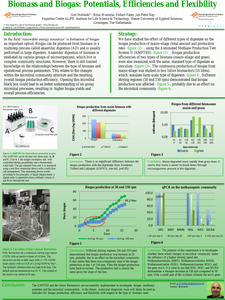In the field of ‘renewable energy resources’ formation of biogas Biomass and biogas: potentials, efficiencies and flexibility is an important option. Biogas can be produced from biomass in a multistep process called anaerobic digestion (AD) and is usually performed in large digesters. Anaerobic digestion of biomass is mediated by various groups of microorganisms, which live in complex community structures. However, there is still limited knowledge on the relationships between the type of biomass and operational process parameters. This relates to the changes within the microbial community structure and the resulting overall biogas production efficiency. Opening this microbial black box could lead to an better understanding of on-going microbial processes, resulting in higher biogas yields and overall process efficiencies.
DOCUMENT
In the field of ‘renewable energy resources’ formation of biogas is an important option. Biogas can be produced from biomass in a multistep process called anaerobic digestion (AD) and is usually performed in large digesters. Anaerobic digestion of biomass is mediated by various groups of microorganisms, which live in complex community structures. However, there is still limited knowledge on the relationships between the type of biomass and operational process parameters. This relates to the changes within the microbial community structure and the resulting overall biogas production efficiency. Opening this microbial black box could lead to an better understanding of on-going microbial processes, resulting in higher biogas yields and overall process efficiencies.
DOCUMENT

A process for the prepn. of arom. compds. from a feed stream contg. biomass or mixts. of biomass, the process comprising: a) subjecting a feed stream contg. biomass or mixts. of biomass to a process to afford a conversion product comprising arom. compds.; b) recovering the arom. compds. from said conversion product; c) sepg. a higher mol. wt. fraction comprising polyarom. hydrocarbons (PAH) from a lower mol. wt. fraction comprising benzene, toluene and xylene (BTX) by distn.; d) reducing at least part of said higher mol. wt. fraction to obtain a reduced fraction comprising polycyclic aliphatics (PCA); and e) subjecting the higher mol. wt. fraction obtained in step c), the reduced fraction obtained in step d), or a mixt. thereof, to a process to obtain lower mol. wt. aroms. (BTX). [on SciFinder(R)]
DOCUMENT

In this proposal, a consortium of knowledge institutes (wo, hbo) and industry aims to carry out the chemical re/upcycling of polyamides and polyurethanes by means of an ammonolysis, a depolymerisation reaction using ammonia (NH3). The products obtained are then purified from impurities and by-products, and in the case of polyurethanes, the amines obtained are reused for resynthesis of the polymer. In the depolymerisation of polyamides, the purified amides are converted to the corresponding amines by (in situ) hydrogenation or a Hofmann rearrangement, thereby forming new sources of amine. Alternatively, the amides are hydrolysed toward the corresponding carboxylic acids and reused in the repolymerisation towards polyamides. The above cycles are particularly suitable for end-of-life plastic streams from sorting installations that are not suitable for mechanical/chemical recycling. Any loss of material is compensated for by synthesis of amines from (mixtures of) end-of-life plastics and biomass (organic waste streams) and from end-of-life polyesters (ammonolysis). The ammonia required for depolymerisation can be synthesised from green hydrogen (Haber-Bosch process).By closing carbon cycles (high carbon efficiency) and supplementing the amines needed for the chain from biomass and end-of-life plastics, a significant CO2 saving is achieved as well as reduction in material input and waste. The research will focus on a number of specific industrially relevant cases/chains and will result in economically, ecologically (including safety) and socially acceptable routes for recycling polyamides and polyurethanes. Commercialisation of the results obtained are foreseen by the companies involved (a.o. Teijin and Covestro). Furthermore, as our project will result in a wide variety of new and drop-in (di)amines from sustainable sources, it will increase the attractiveness to use these sustainable monomers for currently prepared and new polyamides and polyurethanes. Also other market applications (pharma, fine chemicals, coatings, electronics, etc.) are foreseen for the sustainable amines synthesized within our proposition.
By transitioning from a fossil-based economy to a circular and bio-based economy, the industry has an opportunity to reduce its overall CO2 emission. Necessary conditions for effective and significant reductions of CO2-emissions are that effective processing routes are developed that make the available carbon in the renewable sources accessible at an acceptable price and in process chains that produce valuable products that may replace fossil based products. To match the growing industrial carbon demand with sufficient carbon sources, all available circular, and renewable feedstock sources must be considered. A major challenge for greening chemistry is to find suitable sustainable carbon that is not fossil (petroleum, natural gas, coal), but also does not compete with the food or feed demand. Therefore, in this proposal, we omit the use of first generation substrates such as sugary crops (sugar beets), or starch-containing biomasses (maize, cereals).
In het project ‘AgroCycle’ wordt onderzocht of een coöperatie van boerderijen zelfvoorzienend kunnen worden in energie en bemesting door het gebruiken van mest in organische afvalstromen voor de productie van energie, groene brandstof en groene meststoffen door middel anaerobe vergisting. In het project beogen de projectpartners de nutriëntenkringloop (van mest tot digestaat tot groene meststof) te koppelen aan een zelfvoorzienend energiesysteem (biomassa tot biogas tot groene brandstof voor de bewerking van het land) door de gecombineerde productie van biogas en groene meststoffen. De financiële haalbaarheid van een biovergister is sterk afhankelijk van het gebruik en de economische waarde van het digestaat. Met deze gecombineerde aanpak wordt zowel de haalbaarheid als de duurzaamheid (milieueffecten en CO2 - emissies) vergroot. Om de haalbaarheid van dit concept te onderzoeken wordt gebruik gemaakt van het bestaande model ‘BioGas simulator’ dat door de Hanzehogeschool Groningen ontwikkeld is om het technische proces van decentrale productie van biogas te kunnen simuleren.